The Canon EOS R100 is the least expensive model in the fast growing EOS R RF-mount system. An entry level model aimed at beginners and first-time camera owners, it gives you the opportunity to enter Canon’s mirrorless world on a budget.
The thing is: there is another camera, and another system, that is mirrorless, and that has been around for some time: the EOS M line-up. The M50 mark II (and the original M50 before it) have been a good seller for some time, and today the price between the R and the M models is roughly the same.
It is only natural at this point to wonder which one is the better buy. In this article, I’ll guide you throught 10 differences you need to know before making a decision. Some are small, others are very important.
We’re ready to begin but first, a quick summary of the things these two cameras have in common:
- 24.1MP APS-C sensor
- Dual Pixel CMOS AF, Face/Eye detection (people)
- Electronic-first curtain and electronic shutter modes
- Max. shutter speed of 1/4,000s
- 4K video (24, 25p) with a 1.6x sensor crop and contrast detection AF
- 1080 video up to 60p, 720 up to 120p
- Hot-shoe, 3.5mm mic input, micro HDMI output, 2.5mm remote input
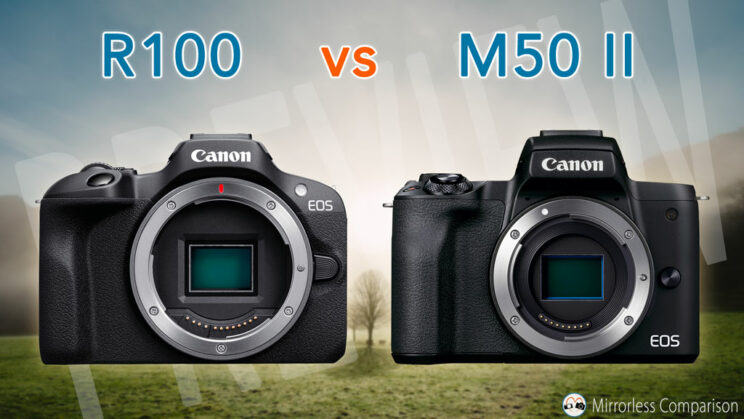
Additional comparison previews:
R100 vs M50 II
Ethics statement: the following is based on official specs and our personal experience with the M50 II. We were not asked to write anything about these products, nor were we provided any compensation of any kind. Within the article, there are affiliate links. If you buy something after clicking one of these links, we will receive a small commission. To know more about our ethics, you can visit our full disclosure page. Thank you!
1. Lens mount
The first point is the most important one to know: these two cameras don’t have the same lens mount. Lenses designed for the R100 (RF mount) won’t work on the M50 II (M mount), and vice versa.
The EOS M series was unveiled in 2012, back when DSLRs were still dominant and mirrorless cameras were mainly seen as compact solutions for amateurs.
The RF mount was launched in 2018 with the original EOS R mirrorless model, with the aim of replacing its DSLR products and compete at every level with manufactuers such as Nikon and Sony. It is the future of the brand when it comes to interchangeable-lens digital cameras.
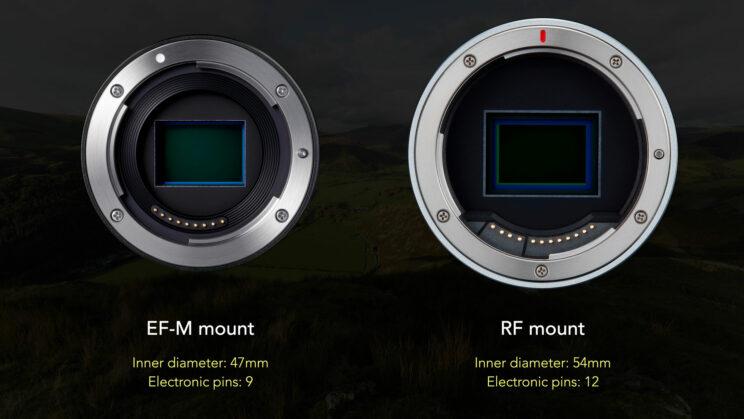
Canon decided to design a different larger mount for the EOS R line-up, partially to accomodate larger sensors (full frame) but also to add more electronic contacts and improve the body-lens communication.
Despite starting 6 years earlier, the M system never grown beyond entry level and enthusiasts models, and the lens selection is limited. The EOS R series already has more lenses and cameras available, for every budget and need.
2. ISO Sensitivity
Although the cameras are supposedly using the same sensor, and same Digic 8 image processor, the ISO levels are different, with the older M50 having one stop extra range, as you can see below:
Camera
Normal range
Extended range
R100
100 – 12,800
25,600
M50 II
100 – 25,600
51,200
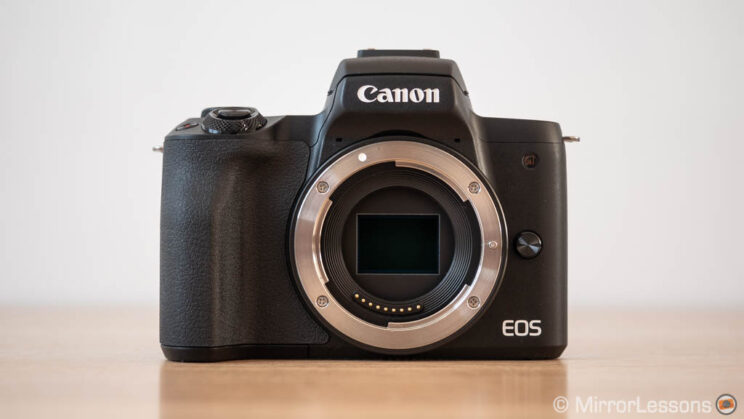
3. Speed
The R100 has modest continuous shooting capabilities: 6.5fps when using One-Shot AF, and 3.5fps when using Servo AF (continous autofocus).
The M50 II is faster: 10fps with One-Shot AF, and 7.4fps with Servo AF.
Concerning the buffer, they have different maximum bursts, but the table shows us that the M50 II has more potential, since it can save more RAW files at a faster speed.
Buffer
R100
M50 II
10 fps
–
36 JPG
10 RAW
6.5 fps
97 JPG
6 RAW
–
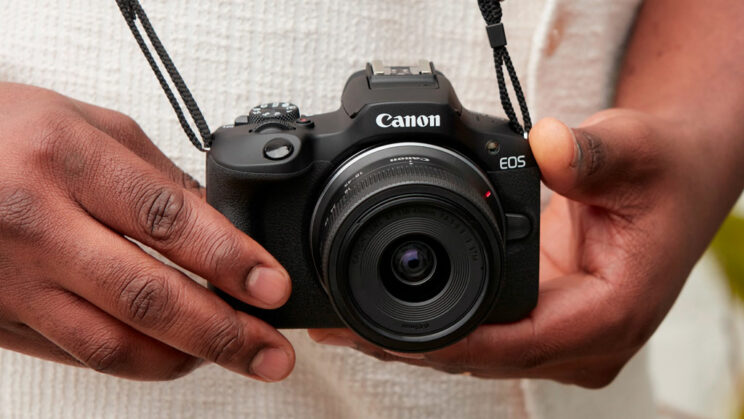
4. AF Sensitivity in Low Light
It’s a small difference, but the M50 II has a 1/2 stop advantage in low light. While both cameras are rated at -4EV and ISO 100, the M model was tested at f/1.4, whereas the R is at f/1.2. This is just a difference on the specs sheet, the disparity in real world conditions could be smaller, and the lens used will also play a role.
5. Design
Although the R100 has a more rounded and thicker appearance, the two cameras share the same official dimensions. The M50 is slightly heavier.
- R100: 116.3 x 88.1 x 58.7 mm, 356g
- M50 II: 116.3 x 88.1 x 58.7mm, 387g
The M50 has one extra button at the top (M-Fn). The control wheel is built into the shutter button, whereas it is separate on the R100. The layout on the rear is identical, expect for cosmetic differences and the position of the INFO button.
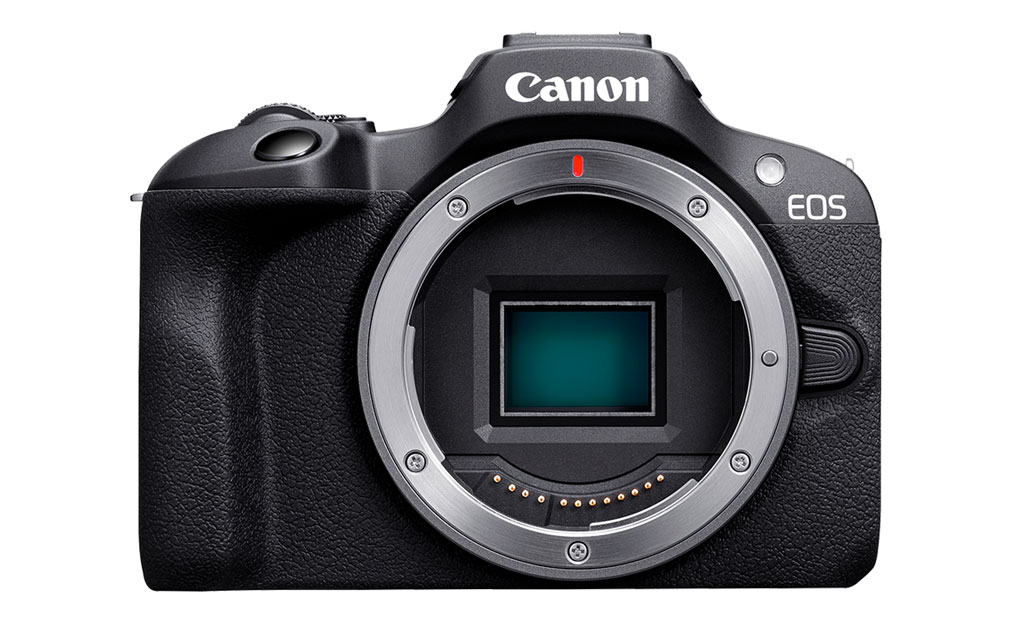
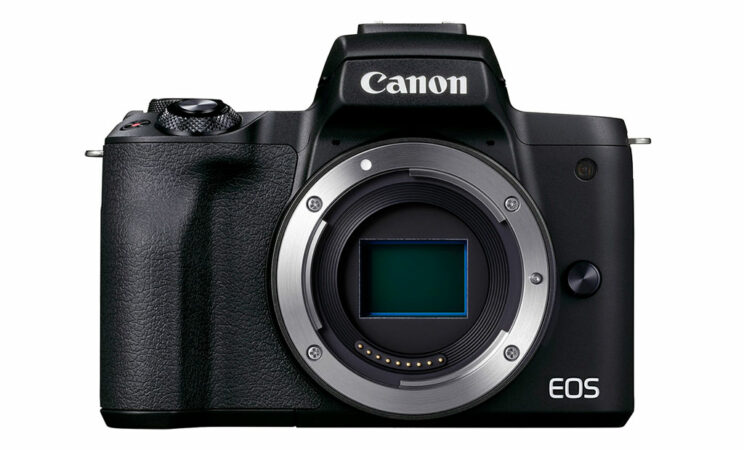
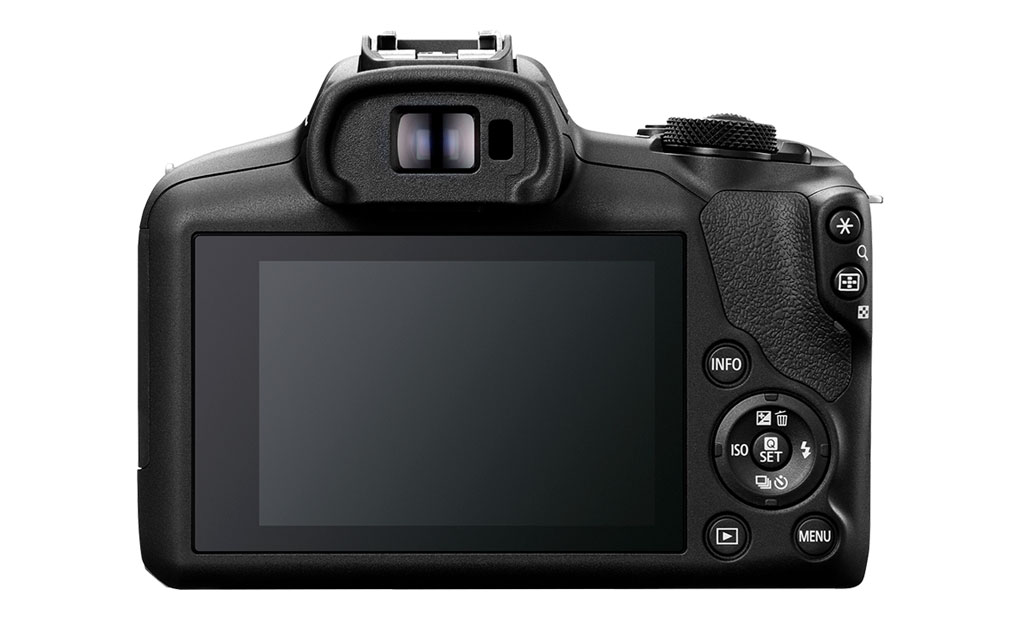
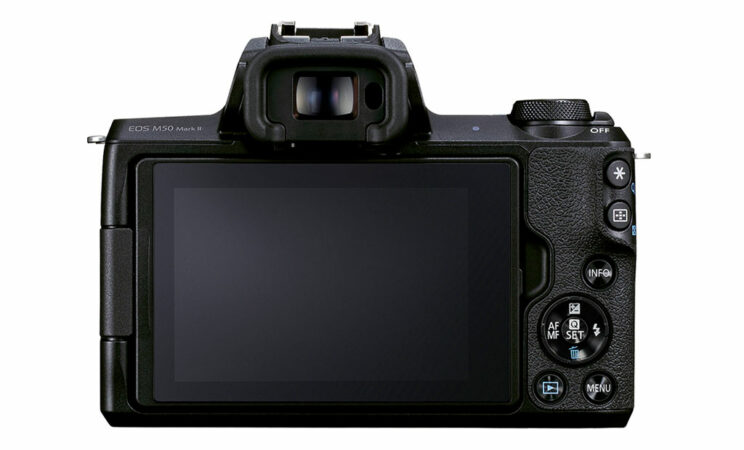
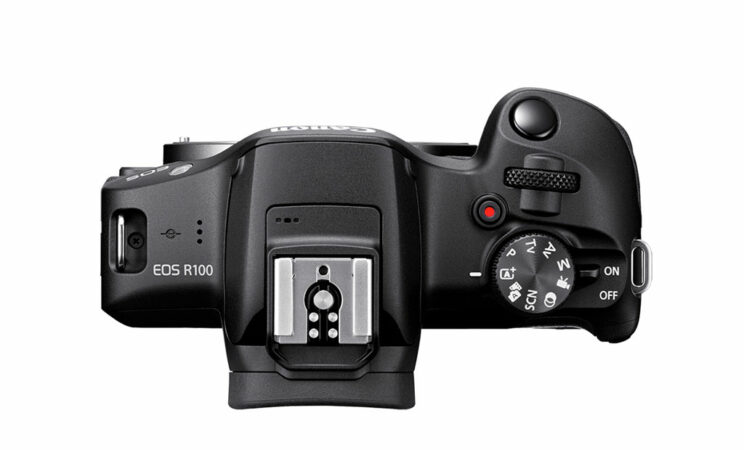
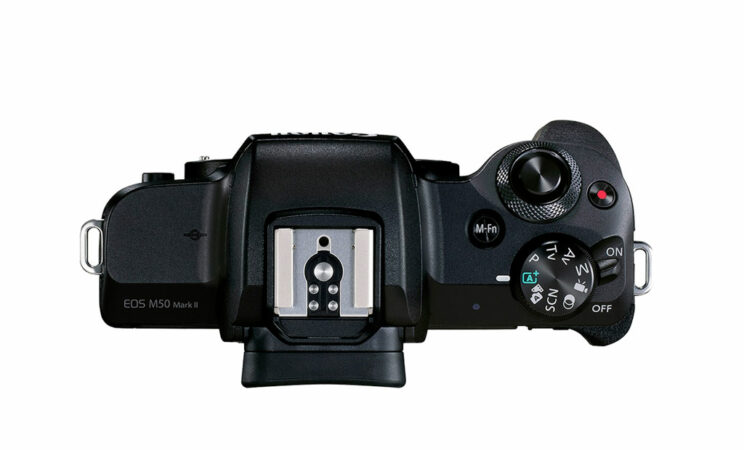
6. EVF magnification
The two cameras have an electronic viewfinder with very similar characteristics:
- 0.39-in OLED panel
- 2.36M dots
- 22mm eyepoint
- 60Hz refresh rate
The only difference is the magnification, which is slightly larger on the M50 mark II: 0.62x vs 0.59x.
7. Rear Monitor
Here is perhaps the most important element concerning usability: the R100 has a fixed LCD screen, and it lacks touch sensitivity.
The M50 II on the other hand has a multi-angle monitor that you can flip to the side and rotate 180˚. It is a touch screen, useful to move the AF point, take a picture or navigate the menu and change settings. As a consequence, the M50 is much more user friendly if you like to V-Log.
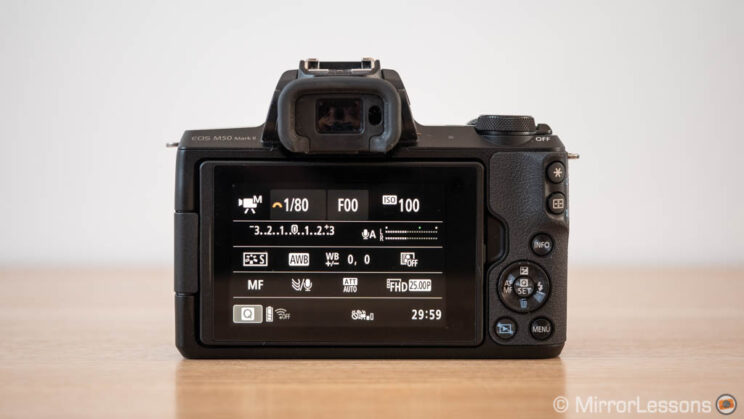
8. Battery
The R100 comes with a charger and the LP-E17 battery, the same found in the R50. The official CIPA data tells 320 shots with the viewfinder, or 400 shots with the LCD.
The M50 II uses the LP-E12, and the rating is lower (aka less battery life): 250 frames with the EVF, 305 with the LCD screen.
9. USB Connection
Another small difference: the M50 II has a micro USB port (USB 2.0), whereas the R100 has a larger USB C port (still USB 2). Neither camera can be charged or powered via these ports.
10. Price
The R100, in a kit with the RF-S 18-45mm zoom, starts at $600 / £670 / €700.
The M50 mark II has a similar price with the EF-M 15-45mm: $600, £630 or €680.
Here’s an extra note: I haven’t compared the two kit lenses so I can’t tell you which one offers better quality, but the EF-M version has a better zoom range on the wide end, starting at 15mm (24mm equivalent), rather than 18mm (29mm equivalent). That can be quite useful indoors, or on tight city streets for example.
Prices are as of late May 2023.
Additional comparison previews:
R100 vs M50 II
First Thoughts
The new R100 feels like the symbolic successor to the M50 whose fate, along with that of the rest of the M series, might already be sealed. After all, it makes sense for Canon to concentrate all their efforts (entry level, enthusiast, prosumer, pro, APS-C and full frame cameras) into one system and one mount, rather than juggling between two different interchangeable-lens systems that are not cross-compatible. In simpler words, the RF mount is here to stay. The M mount, not so much.
The problem is that camera companies rarely declare upfront that a line-up is done and dusted. Silence, no updates, and products marked as discontinued on retail websites are usually the only clues. At the time of writing this article, the M50 mark II and other EOS M cameras are still on the market, and popular. I doubt we will see new models, or new lenses, but I suppose Canon will continue to sell the existing products as long as they have stock and there is demand.
The question is, if you’re a beginner looking for your first buy, which one of these should you invest into? I would be inclined to say R100, because the future of the EOS R system is guaranteed. For example, if you were to upgrade to a second camera in a few years, you’ll have the reassurance of knowing you can continue to use the same lens(es) you already possess. If you want to upgrade from a M50 to an EOS R camera, you’ll have to upgrade the lenses too.
What is bugging me however, is that the R100 feels to me like a lame product. I understand why Canon decided to use old spare parts to keep the cost down, but not even having a tilting screen with touch sensitivity in 2023 makes the camera look ancient. From a user experience point of view, I actually prefer the M50 II: it has a multi-angle screen, touch sensitivity, shoots faster and even has a better ISO range.
I suppose, if you only care for a decent camera, one or two lenses tops, without the prospect of upgrading anytime soon, the M50 II can serve you well, and it’s not like it will suddenly stop working when Canon pulls the plug on the M series.
Check the price of the Canon R100 on
B&H Photo
Check price of the Canon EOS M50 II on
Amazon | Amazon UK | B&H Photo | eBay


